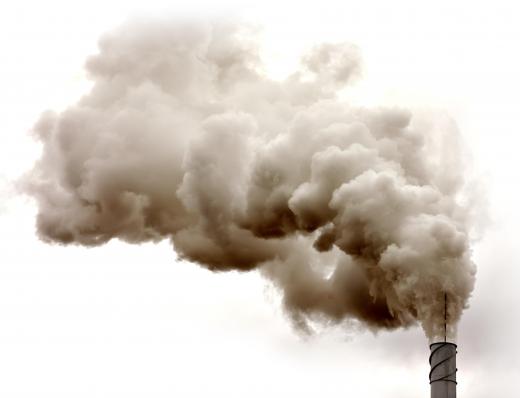An industrial scrubber is a device used to remove pollution from smokestacks and exhaust systems. The scrubber system keeps harmful chemicals and fumes from entering the atmosphere, and many are designed to capture both gases and solid particles. Adequate air pollution control helps to reduce carbon and other emissions, which can in term reduce the effects of ozone depletion and global warming.
Any industrial plant or manufacturing facility may install an industrial scrubber to reduce air pollution from smokestacks. These scrubber systems are particularly relevant to factories that use harmful chemicals or dangerous gases during production. An industrial scrubber can also reduce emissions from furnace flues or other exhaust systems, even those that are not associated with toxic fumes or chemicals.

Once exhaust air leaves a furnace or piece of manufacturing equipment, it passes through the building's duct network before entering the scrubber. An industrial scrubber collects any potentially harmful materials from the air, then releases the clean air out through a smokestack or exhaust vent. Some systems also contain a heat recovery coil that collects any heat energy from the air so it can be transferred back to the building's heating unit for reuse.
The hazardous materials collected by an industrial scrubber can be handled using one of three basic techniques. Many are sent to a recycling facility for safe handling and reuse, while others are neutralized and disposed of through regular waste channels. Still others are recirculated through the plant and reused in internal manufacturing processes.
There are two basic types of industrial scrubbers systems, categorized as "wet" or "dry." Wet systems use water or liquid chemicals to collect polluting substances from exhaust air. These systems work with both gaseous and solid material, and can even handle corrosive materials. Dry scrubber systems use chemicals to absorb or dissolve hazardous materials in the air, and work better with gaseous materials than they do with solid waste particles.
Industrial scrubbers provide numerous benefits to the environment. They help prevent global warming and acid rain while keeping air quality levels high. By lowering hazardous emissions, they protect nearby residents from potential health problems caused by these materials. Scrubbers also reduce odors and prevent dangerous materials from polluting local land or waterways.
Scrubber systems require a great deal of maintenance in order to operate properly. They must be cleaned regularly, and all filters or material collection devices should be emptied or replaced. A poorly maintained scrubber is not only ineffective, but can become a breeding ground for disease-causing bacteria.
